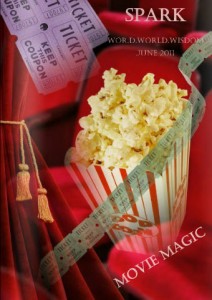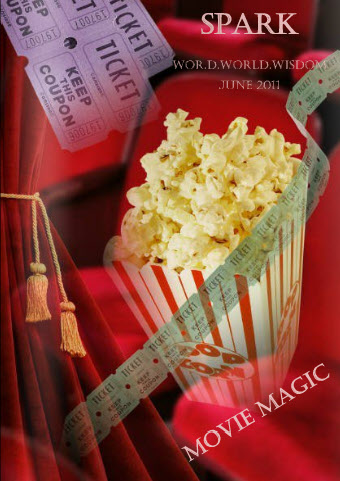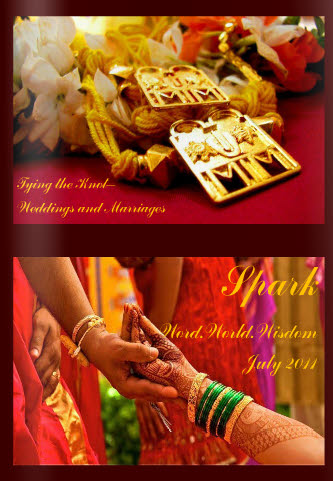by Yayaati Joshi
[box] We sure are not going to play spoilsport by saying what film Yayaati Joshi has picked to revisit and share his personal view. Since we say film, you may have already guessed which theme this piece has set out to honour. Yayaati’s article is written to celebrate the spirit of the June 2011 issue, ‘Movie Magic’.[/box] [box type=”info”] MONTH: June 2011
MONTH: June 2011
THEME: MOVIE MAGIC
CONCEPT: A magazine’s journey is incomplete without an issue that pays tribute to cinema. So for our June issue, we decided to do just that.
FEATURED WRITER OF JUNE 2011: Jai Arjun Singh, Freelance writer, Journalist and Author of ‘Jane Bhi Do Yaaro’ and ‘The Popcorn Essayists.’
What’s life without cinema? Having earnestly pursued themes for a while, we thought it would be a good idea to dedicate one issue to movies just like we had done for the written word in 2010. Again, interesting varied perspectives are what we got as responses to the topic. From music to stage adaptations to movies to telefilms to the very experience of watching movies, we had it all in this edition. Movie lovers, check this out![/box]
Riddle me this: Which is that one Indian film that many people claim to have seen over 50 times? Ok let me drop a hint –you don’t need one, if you read the title of the post.
Well, for those who thought the answer was Andaz Apna Apna, my apologies, I was referring to Sholay. For those who got it right, let’s do a high-five! It is tempting (and tedious as well) to write about Sholay. In this personal essay, though, I have restricted myself to writing about a few (usually unnoticed) aspects of the film.
Sholay – my earliest memories of this landmark film are of watching the movie in a cinema hall as a seven-year-old. And at that age, it looked pretty good. Even later, every time I saw it, there was something about it that I really liked. Each time I discovered a different thing or theme about the film that I hadn’t noticed in the previous viewing. I’ve seen the film around six times, and the last time I saw it was about six years ago. Now this “gap” is important in a couple of ways – for one, it tells me that at least in the case of this movie, my memory serves me well – I still remember most of the film. The other thing, which is more of a personal lament, is that I now rarely get to watch the television, and I miss out on several good movies that are regularly shown.
Sholay is the perfect entertainer – it has something for everyone in its wide gamut of themes. Even as a seven-year-old kid of average intelligence, I understood Veeru’s frustration and anger on losing his friend; the bad, bearded guy will be beaten up badly, I remember telling myself. Subsequently, when I watched the movie a few more times, other aspects of the film, not just the fight scenes and Veeru’s foolery (which was amusing), became apparent.
One thing that I really ‘missed out’ on (as a kid) was the hint of a subtle “romance” between Jai and Radha. There was this much talked about scene in which Radha blows out the burning lamps, while Jai’s gaze is directed at her. Now the way this scene is described here may make it seem like a totally romantic shot, whereas in the film, it actually looks astonishingly simple. This is where the acting comes in handy – without even exchanging words, it is made evident that there is something more than just a ‘passing intrigue’ happening between the two. The other thing that I missed out was the dry humour of Jai – the first few viewings were always about the train “fight” (as a kid, all sorts of action, even the types shown in Independence Day, was categorised broadly under “fighting”). When I saw it for the last time, much to my delight, Jai’s humour was what I enjoyed the most. Usually, the funny bits of Sholay are along the lines of those done by comedians employed for that specific purpose. But one scene from the film, which to me is funnier that anything else in the movie, is Jai’s description of his closest friend. This is during the aged, insecure mausi’s attempt to find out more about Veeru – as is still the custom in a lot of arranged marriages. One after the other, Jai highlights, with slight exaggeration, his friend’s quirks – drinking, gambling, keeping the company of nautch-girls, while being very “supportive” of his friend’s benign intent to marry Basanti. After hearing all this, with a philosopher’s “I knew it” countenance, the mausi remarks that despite many foibles, Jai is very supportive of his friend. To this, Jai remarks, with a certain thanking expression on his face, “Mera to dil hee kuch aisa hai” (More than the literal translation, it is the intent which is important here. After messing up, Jai masochistically sums up that he is too kind hearted not to like his close friend, the foibles notwithstanding).
Before Sholay, Amitabh was always cast as the angry young man and his roles were such that it would have been impossible for someone to expect him to “do comedy”. Perhaps the only “funny film” that Amitabh did prior to Sholay was ‘BombaytoGoa’. And it wasn’t as if after Sholay, Amitabh was bombarded with offers where he had to play a funny role; given the grandeur of the film, Amitabh’s comic act was carefully concealed while other plot-based priorities were placed first.
As a film, Sholay has perhaps more folklores associated with it than any other Indian film. It was released at a time when its genre was not known to many people. Now, most critics and film historians classify it as a “Western” film, but back then, were the masses even aware of the “Western” films of Hollywood? How many people would have seen ‘Once Upon A Time In The West’ from which Sholay is supposed to have been inspired? But the ‘stories’ around the making of the film have been primarily about how Amitabh and Dharmedra felt about sharing screen space with each other, how the film was important in bringing Jaya and Amitabh closer (the couple’s daughter was born around the time Sholay released) perhaps to be ‘separated’ shortly, thanks to Rekha. Obviously, gossip mongers had had a hard time then, in the absence of the Internet!
Gossip aside, one such legend, the veracity of which I could not verify for several years (before I stumbled upon IMDB) was that this was Amjad Khan’s debut film. I was told this at a time when the word ‘Internet’ was so new that I hadn’t even created an email account. And obviously, in the absence of Wikipedia and IMDB, it was hard to verify such claims. Later, when I did familiarise myself with IMDB, I looked up the filmography section on Amjad Khan, and realised that although Sholay wasn’t his debut film, he was a relatively new actor when he did the film. It really would have been tough for a less experienced actor to act as Amjad Khan did in Sholay. My admiration for his talent and the movie’s magnificence continues to increase despite the film getting ‘older’.
Older films, sometimes even the ones that aren’t worthy of the edification, are often termed as “classics”. But Sholay, because of its flawlessness is truly a classic – a film that shouldn’t just be watched – it should be ‘studied’. Watch it again, and you are sure to be entertained by some facet or the other.
Yayaati Joshi is a man with simple tastes and intense beliefs. Contrary to the bling associated with the capital city, he prefers the company of close friends, an engaging book or an Alfred Hitchcock movie. His placid demeanour is often mistaken for reticence; Yayaati is a self- proclaimed loner, whose recent pursuits include his foray as a budding writer. Yayaati blogs at http://rantingsofadelusionalmind.wordpress.com
[box type=”download”] If you have trouble opening the PDF, please right click on the button and select ‘Save Link As/Save Target As’. This will help save the PDF to your computer. If you still have trouble, drop us a mail at editors@sparkthemagazine.com and we will mail you the PDF straight to your inbox! DON’T MISS THE PDF EXPERIENCE![/box] [button link=”https://sparkthemagazine.com/wp-content/uploads/2012/01/spark-january-2012.pdf” color=”red” newwindow=”yes”] Read it all at one go! Download the PDF here![/button] [button link=”http://issuu.com/sparkeditor/docs/spark-january-2012?mode=embed&layout=http%3A%2F%2Fskin.issuu.com%2Fv%2Fcolor%2Flayout.xml&backgroundColor=000000&showFlipBtn=true” color=”green” newwindow=”yes”] Flip and read like a mag on the e-reader! Click here![/button]
[facebook]Share[/facebook] [retweet]Tweet[/retweet]









[…] edited version of the article can be read here] Share this:FacebookTwitterLinkedInEmailRedditLike this:LikeBe the first to like this post. Posted […]